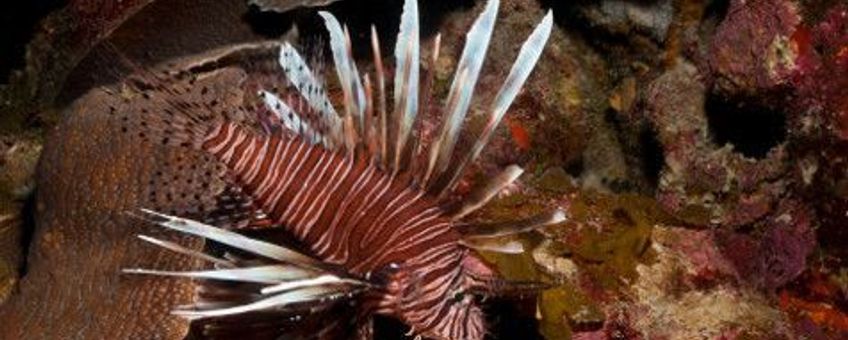
Beheermaatregelen Koraalduivel blijken succesvol
Bericht uitgegeven door Dutch Caribbean Nature Alliance (DCNA) [land] op [publicatiedatum]
Naast dat de Koraalduivel (Pterois volitans/miles) een van de mooiste en sierlijkste vissoorten is die tegenwoordig op de Caribische koraalriffen voorkomt, is er tevens een duistere kant aan zijn bestaan. De natuurlijke omgeving van de Koraalduivel zijn de koraalriffen van de Pacifische Oceaan en tot 2009 kwam hij niet voor op de riffen van de Nederlands Caribische eilanden. Door zijn snelle voortplantingscyclus (30.000 eitjes per vier dagen), unieke manier van jagen, onverzadigbare honger en het gebrek aan natuurlijke predatoren, heeft de Koraalduivel zich over de hele Caribisch Zee kunnen verspreiden en vormt hij nu een bedreiging voor de inheemse biodiversiteit van de Caribische koraalriffen. Onderzoek op de Bahama’s heeft uitgewezen dat meer dan 75% van de jonge aanwas van inheemse vissoorten is verdwenen waar de Koraalduivel voorkomt.
Lees verder in het Engels…
Despite being one of the most beautiful and elegant fish on the Caribbean coral reefs nowadays, the Lionfish (Pterois volitans/miles) has a much darker side to its existence. Native to the Indo-Pacific region, Lionfish could not be found anywhere in the Dutch Caribbean prior to 2009. Their rapid reproduction cycles (30,000 eggs every four days), unique hunting style, voracious appetite and lack of any significant predator make the Lionfish an ominous threat to Caribbean reef biodiversity. Studies in the Bahamas have shown an alarming >75% reduction in juvenile native reef fish where Lionfish are present.

Since its first occurrence in the wider region in the early 90s, various Caribbean islands have taken different approaches how to deal with the invasion, ranging from immediate control efforts to a deliberate hands-off approach. Being highly dependent on dive-tourism, Bonaire, as well as other Dutch Caribbean islands, has taken a pro-active approach to combat the lionfish invasion with the help of trained volunteers. Additionally, systematic assessment studies were carried out by the nature conservation organisations on the islands to measure the effectiveness of the control programmes.
Complete eradication is impossible due to constant recruitment from unfished locations, such as locations too deep for recreational diving and/or inaccessible locations. However, new research suggests that continuous control efforts may be able to suppress the population and eventually allowing native fish stocks to return. A predictive study using computer models, as well as data collected from 24 coral reefs in the Bahamas, found that if 75 to 95% of the Lionfish on a single reef were removed, the native fish would increase 50 to 70% within 18 months. The biomass of larger individuals, including ecologically important grazers and economically important fisheries species, had increased by 10 to 65% by the end of the 18 months. By contrast, the biomass of small native fishes declined by more than 50% on all reefs where Lionfish densities were insufficiently suppressed during the experiment.
A first evaluation of the effectiveness of the lionfish removal programmes on Bonaire and Curaçao also indicates that they have a significant impact. Lionfish numbers are almost three times lower in fished areas over unfished areas on the same island. This proves that control efforts using volunteers are successfully reducing local density and biomass of lionfish on our reefs, which helps protect our native reef fish species.
In 2012, an online application was developed by STINAPA Bonaire and DCNA to allow park staff and lionfish hunters to record their observations and lionfish kills on Bonaire (www.lionfishcontrol.org). The application allows this data to be viewed on a map, which gives an unprecedented insight into lionfish distribution and removal efforts and allows park staff to begin to gauge the effects of their population control efforts. This web-based and mobile-device-friendly application has recently been expanded to include Aruba, Curaçao and St. Maarten after a successful pilot period on Bonaire in which over 10,000 records have been entered.
Now, Lionfish hunters and ocean-going public from Aruba, Bonaire, Curaçao and St. Maarten can record their observations and captures of Lionfish in an easy-to-understand and informative way. In combination with additional research, the information provided by this citizen science initiative gives unprecedented insight into lionfish distribution and success of removal efforts.
Lees het hele artikel in BioNews
Tekst: Dutch Caribbean Nature Alliance (DCNA)
Foto: Rudy van Geldere
Gepubliceerd door: Dutch Caribbean Nature Alliance (DCNA)
Nederlandse inleiding: Paul Westerbeek (Dutch Caribbean Nature Alliance)

